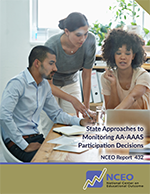Individualized Education Program (IEP) teams determine how students with disabilities will participate in statewide assessments. Most will take the general assessment, with or without accessibility features and accommodations. A small number of students with the most significant cognitive disabilities will take an alternate assessment based on alternate academic achievement standards (AA-AAAS) because they are unable to take the general assessment even with allowable accommodations. Assessment participation decisions should not be made lightly because that decision has many implications for instruction and students’ future options. NCEO conducted a survey of state special education and assessment directors to learn more about states’ policies, practices, and procedures for monitoring AA-AAAS participation decisions.
The survey findings were published in a NCEO report titled, State Approaches to Monitoring AA-AAAS Participation Decisions. Policies and processes varied widely across states, but the survey found that a team usually reviewed IEPs for AA-AAAS decision making. Most commonly a monitoring team was comprised of state education agency (SEA) special education monitoring staff, but assessment specialists also sometimes participated. In most cases, states monitored a selected sample of IEPs (not all IEPs). When reviewing IEPs, more states reported doing a virtual review than an in-person review; however, it was common for SEAs to conduct both virtual and on-site reviews.
If a state determined that there was insufficient evidence to determine that a student qualified for the AA-AAAS, the state generally worked collaboratively with local education agencies (LEAs) to review the process that was used when the decision was made.
The report concluded that reviewing IEPs for AA-AAAS participation is an evolving process, and it is anticipated that states will continue to refine their monitoring processes. States should continue to determine what works best for their specific circumstances and provides the best results, given their available resources. At a minimum, all states should have an established process for monitoring AA-AAAS participation.

